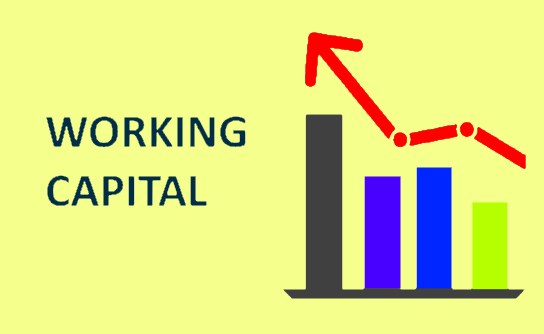- 7 creative options to increase your working capital - February 17, 2020
- 7 common myths about selling your business - February 6, 2020
- Why you should focus on existing customers rather than new ones - February 6, 2020
Working capital is the money used for paying everyday business expenses or used to expand the business or take on a larger contract. It is essential for any growing business.
We often discuss the needs of working capital with business owners and find it a largely misunderstood area. We hope to give some understanding here to enable your business to implement some better working capital management strategies.
For some smaller businesses simply better management of their cashflow can be the main step to improving their working capital. We had some suggestions for that in a previous article here.
For other businesses they may need to look to more creative approaches such as loans and other financing options. We will look at some of these options later on.
After all, your business needs to have enough capital on hand to run your daily operations but equally you don’t want to have money just lying around (a nice problem to have but not the best use of your capital)
We will start with come background:
Firstly, what is working capital?
Working capital is the amount of cash a business can safely spend. It is seen as ‘working’ as the business can use it now, it is not tied up in anything long term. More than likely this will be cash in the bank or some other short-term investment that can be accessed quickly.
Working capital is important because it is used to measure how much money you have left to run your business after you’ve accounted for all of your short-term liabilities.
Working capital is the difference between your current assets and current liabilities. It can be calculated use this simple equation:
Working Capital = Current Assets – Current Liabilities
Example:
If a business has £6,000 in the bank, a customer that owes them £3,375 (current assets), an invoice from a supplier payable for £2,500, and a VAT bill worth £5,000 (current liabilities)
Working capital = (6,000 + 3,375) – (2,500 + 5,000)
= £1,875
Ideally, your current assets should outweigh your current liabilities, leaving you with a positive number when you complete the working capital equation. If you have positive working capital, you can pay off your business’s debts and still afford to purchase inventory and run other business operations.
If your current liabilities outweigh your current assets, you have negative working capital and may find it difficult to pay your debts, purchase inventory, and run your business.
Outside of some other change within your business to address this fact you will likely need to source some form of capital funding to meet these liabilities.
It is important to note that this route is only followed where the business is in a strong financial position otherwise. Funding an underlying problem within the business is only a short-term fix to an overall decline in the business. It is important to be mindful of this fact.
How much working capital does your business need?
Ideally, you want enough working capital to cover your business expenses and pay your debts, but you also want to be using your assets to further invest in your business.
The Working Capital Ratio:
One way to gauge your business’s efficiency and financial health is by using the working capital ratio. Here is the working capital formula:
Working Capital Ratio = Current Assets / Current Liabilities
Let’s return to our example from earlier, where the company has £9,375 in current assets and £7,500 in current liabilities.
The businesses working capital ratio = 9,375/ 7,500 = 1.25
But what does this number mean?
Investopedia suggest you preferably want a ratio between 1.2 and 2.0. If your working capital ratio is lower than 1.2, it can indicate that you may have difficulty paying your bills and expenses on time. If your working capital ratio is higher than 2.0, you may not be investing in your company or in new growth opportunities as you should.
The working capital equation gives you a guide to help your business find that ideal point between paying existing debts and expenses whilst preparing for and investing in future growth in the business.
Alternatively, this equation can help you determine of additional working capital funding is required what amount that should be.
Some of the common reasons businesses need Working Capital loan finance:
- To manage an inconsistent cash flow
- To manage the demands of seasonal sales fluctuations
- To enable business growth
- To allow the access to new business opportunities
- To provide an ongoing cash buffer
The right kind of working capital finance
As with all finance applications and decisions it is important to take some expert advice.
Here are some of the financing options that are available and may be suitable for your business, and a brief summary of each:
- Overdrafts
Have traditionally been used across a wide range of businesses
Pros: Simple source of funding, only pay for what you use
Cons: More difficult to access through business banks, more options available through alternative finance routes. Often have low credit amounts so may limit your plans
- Working capital loans
Secured working capital loans will require assets to use as security, so the amount you can borrow is restricted by the assets available.
However, it is possible to access unsecured business loans to help with working capital. These loans require a strong credit rating, and you’ll often have to give a personal guarantee.
Pros: More flexible products now available on the market
Cons: Fixed period, fixed rate, you receive all money and therefore pay full amount of interest from day 1. Unsecured loans with personal guarantees can tie your personal assets into your business.
- Invoice financing (includes factoring, invoice discounting, confidential invoice financing, and selective invoice financing)
Various different flavours of the same thing are available for business who offer their customers credit terms. Invoice financing is based on money owed to your business, whereby you receive a percentage of the value owed on one invoice or your entire debtor list.
Pros: Can be a simple as offering your customer a discount on prompt payment
Cons: More advanced factoring type services are generally very expensive and once used businesses can become ‘hooked’ into this cycle and find it difficult to remove themselves from this system
- Crowdfunding or peer-to-peer lending
There are so many options available these days, which rely on the concept of many ‘lenders’ contributing to a large pot of money which can then be lent out.
Some will have options to give away equity instead of paying interest
Pros: These models are now quite advanced, companies are used to lending to businesses and this process is often far less onerous than accessing funding through a traditional bank
Cons: Often percentage equity required under this scenario will be quite larger, this might appear a cash effective means of accessing money in the short term but can be very costly longer term,
- Trade finance
Designed for businesses that focus on physical stock rather than services rendered. It is a more complex finance partnership that facilitates international trade, and often involves arrangements like prepayment for the shipment of goods from overseas manufacturers.
Pros: Useful option for larger international businesses
Cons: Complex and costly finance option and can take time to get set up
- Asset refinancing
If an unsecured business loan does not meet your funding requirements or you would prefer not to give a personal guarantee, then you can often use the assets in your business to raise finance. The amount you borrow will depend on the value of the items you use to secure it.
Pros: Maintains business financing ‘within’ the business and does not bring your personal assets (e.g. Your home) into the business and potentially puts them at risk
Cons: May be more expensive that a more traditional loan. Will work on a low percentage of value of assets used to secure them as some of these assets depreciate over time.
- Merchant cash advances
If your business accepts payment from customers using card terminals, a merchant cash advance may be an option, meaning businesses like retailers, pubs, cafés and restaurants are all suitable.
The amount you are advanced is normally expressed as a percentage of your average monthly card revenue (e.g. 120% of an average month), and critically, repayments are taken as a percentage of future card revenue too.
Pros: Repayment is simple as they’re taken at the source.
Cons: Important to be aware of the repayments and ensure you are not recording a reduced sales figures which will distort the financial information of your business.
- Business credit cards
In our experience best if only used for very short term means within the specified credit limit
Pros: Relatively easy to access – funding available when needed. Cheap if paid off in full each month
Cons: Is a very expensive annual rate is balance is maintained on the card and not paid off in full each month.
In Summary
As you can see there are many Working Capital financing options, some or all of which may be suitable to your business.
The important point in summary is to ensure that you are maintaining a good eye on your businesses ongoing Working Capital Requirements so that if there is a need for some additional finance you are prepared for and have planned for this eventuality. This will mean your business is able to meet its ongoing requirements and in the most efficient way.
We have assisted many businesses with finance to support, grow or as they sell their business and have access to excellent options, which we would be happy to help you with. Please get in contact with us if this is something we can help you with.

